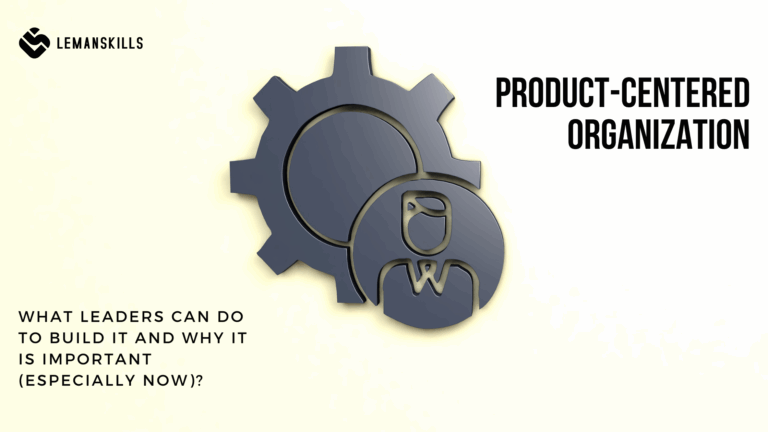Agility, being Agile, using Agile tools.
For the last couple of years those words or phrases became viral: there are so many training sessions, certification programs, workshops and growth paths connected with this. Thinking in an agile way or leading with agility appeared in the job descriptions, since it looks like a leadership skill that is necessary in these crazy, fast pacing time where things are changing all the time.
And yes, it is a quality that can be extremely useful, because the change was, is and will be with us no matter what, regardless of the period of history we live in at the certain moment. But I’ve seen many times that this subject was copied and pasted from the project management books (literally 1:1) and not really tailored to the context of managerial work. There are many common points of working as leader with the team and while being a project manager, but there are also many differences that need to be taken into consideration. To have useful tools, that can be implemented successfully, without frustration that it doesn’t work, or is not applicable at all to the certain circumstances.
So today, we are going to go deeper into the subject and see how to lead teams with agility in 3 areas by using what is the best in agile into the reality of a manager.
1. Reshape your mindset (from fixed to growth)
Leadership agility is a set of competencies, abilities and attitudes. But the most important thing of all this is mindset.
Mindset combines all the thoughts, convictions, beliefs and abilities we have, and it creates the way we look at the world. These are the glasses that we put on to see and interpret what is happening around us.
A leader that has a fixed mindset sees the world of restraints, sometimes without a perspective for it to improve. This person operates daily based on thinking about the change as a threat, something that can rob him/her from what they’ve work on so hard for years. They see new things as challenges to the status quo that are in their comfort zone, often by using the sentence: “it always worked, why to bother changing it?”.
A leader with a growth mindset at the other hand has an open-minded perspective, she/he thinks holistically, looking for opportunities and space to learn every day. Every mistake is a chance to learn, be better next time and have a constant possibility to try different approaches, ideas, making their workspace a better environment for their people.
When you have a fixed mindset as a leader, you will probably never go to the agility leadership space. Agile means adaptive, changing regarding the circumstances, tailoring the approach, response or reaction adequately to the current situation. To modify the way of leading people and business as needed. People with fixed mindset are not that flexible, they are not going to be able to do it.
If you want to be an agile leader, you need to make a shift in your mindset. Move from fear to courage. From ended version to the iterative one, with a constant possibility to improve and adapt.
Why it is important? Because if you have a fixed mindset, your people will have it too. They won’t grow exponentially; they are not going to be high-performing teams with an ability to achieve anything they want. They’ll stay in their comfort, safe space where it’s cozy and warm. But there is no chance to thrive in the comfort zone.
2. Look for opportunities to learn all the time
Once the right mindset it there, the next steps on the journey are possible to implement.
Leading with agility requires learning all the time: trying to find the best options, to improve the ways the team works, operates, solve problems or makes decisions. For a leader that works with people in that way, it’s crucial to seek for opportunities to grow every day. As mentioned in one of the previous articles: “If you didn’t fail today, it means that you haven’t pushed yourself hard enough. Be better tomorrow”.
If you make a mistake, ask yourself: “What have I done well? What could I do better next time?”.
Being an agile leader means using the right tools. Use retrospective with yourself on a daily/weekly/monthly basis. Invest 3 minutes of your time each day to see what went really great, and what could have been better. It’s not a lot of time: every person can manage to do it. The key here is to prioritize it, to know what kind of advantage it brings to your table.
That’s how we learn: remember 70/20/10 rule. 70% of the learning comes from day-to-day tasks, experiences, projects and many different situations we face. 20% is mentoring, feedback, observing others. And 10% is formal (or less formal) education, workshops, studies etc.
Use your 70% daily, the best way you can possibly do it. Be mindful about what you do with your time, how you talk to your people, how you solve problems or create space of others to solve it by themselves. How you pass the responsibility to others, how you strengthen your team to be in charge of what they do. How you delegate tasks 100%, without being a nano manager, but with a trust in employees: that they’ll do their best to cover it, in the best quality they can.
Talk to other people that you find experts in your field. Share knowledge, ways of working or experience you gathered all along the way, be curious about their experiences and learnings too. Follow them on social media, read or listen to the books, get inspired, try what they’ve done to see if it can work in some way in your case. Life the life-long learning value: this is the key to lead with agility.
3. Be adaptive, react and let people do the same
Agility means adaptability. Reacting to changes, making the best of them. Agile leader is a person that believes in chances that are coming with the variety of options this world has. It means that there is always something that can be done better, smarter, in a different, more optimal way. Change isn’t a threat: it’s another option to be innovative, to make something that no one ever thought about.
This is also a part of a growth mindset. Being flexible, trying different approaches, choosing the best one that fits to the certain scenario.
When the company that you work in implements a new piece of software, you can see how it can simplify and edit daily work of yours and your team.
When your boss tells you to look around for new career opportunities, since the org structure is going to change soon, you take this chance to move yourself forward, maybe in a different, more developmental direction.
Of course, you can do quite the opposite: you can flight, fight or freeze and wait for the better times. But it’s not going to be agile leadership behavior.
Agile leader goes with the first scenario. And what’s even more important, she/he lets the team do the same things. To make mistakes, to learn from them. Try different options, approaches and pick the best one. But also it might appear that in 6 months, the solution that we chose today is not going to be the best one anymore. And it’s fine to change it again for something that can work better. To not fix yourself on one solution, when there is an infinity of them in the world. It’s so important to give people freedom, autonomy to make their own choices, but at the same time they take the full responsibility for the consequences (good or bad).
It’s hard. It can be difficult every single time you want to go to your old habits and control everything, ask never-ending questions about statuses of work or go with your own solutions (because they are the best ones, right?). But agile leadership is all about trust, creating high-performing teams that can work and flourish on their own. And if you read this article, I’m guessing that you want to be that person: so, you need to make an uncomfortable action and go all in with new set of behaviors and decisions.
Ask good questions. Agile leader is not assuming, doesn’t play guesses game. That way people will go with you on this journey, changing the way you operate as a team, that you build your relations among yourselves (and with other teams as well). They are going to be extraordinary, starting with their ways of thinking, ending with their decision-making processes. At work and in private life.
Because this is a holistic approach that successful people use. Do you want to be that person?




